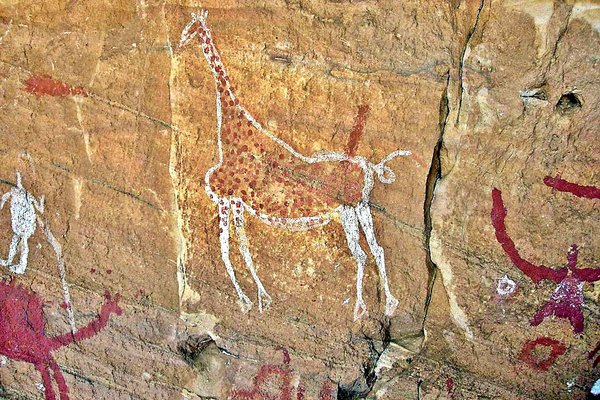Libya
Tadrart Acacus
The Rock-Art Sites of Tadrart Acacus hold thousands of cave paintings that reflect the way of life of different Saharan civilizations.
The mountain massif of Tadrart Acacus is located in the desert area of western Libya. The paintings and engravings were done on its rock walls and in rock shelters. They date from 12,000 BCE to 100 CE and reflect cultural and natural changes in the area. They depict animals such as giraffes, elephants, ostriches and camels, but also men and horses.
Community Perspective: it borders the very similar Algerian WHS Tassili n'Ajjer, and according to Zoë you can hop across to set foot in both parts.
Site Info
Official Information
- Full Name
- Rock-art Sites of Tadrart Acacus (ID: 287)
- Country
- Libya
- Status
-
Inscribed 1985
Site history
History of Tadrart Acacus
- 2016: In Danger
- Simultaneously with the four other World Heritage sites of Libya "because of damage caused by the conflict affecting the country and the threat of further damage it poses".
- 1985: Inscribed
- Inscribed
- 1984: Deferred
- At request of Libya
- In Danger
- Simultaneously with the four other World Heritage sites of Libya "because of damage caused by the conflict affecting the country and the threat of further damage it poses". Since 2016
- Type
- Cultural
- Criteria
- iii
Links
- UNESCO
- whc.unesco.org
- Official
-
- temehu.com — Acacus
All Links
UNESCO.org
- whc.unesco.org — whc.unesco.org/
Official Website
- temehu.com — Acacus
News Article
- July 7, 2023 newarab.com — The Acacus Mountains' final cry: Prehistoric civilisation dating back 14,000 years on the verge of extinction
- June 7, 2014 chicagotribune.com — Vandals destroy prehistoric rock art in Libya's lawless Sahara
Community Information
- Community Category
- Archaeological site: Rock Art
Travel Information
Red Zone Travel Advisory
Recent Connections
-
Red Zone Travel Advisory
Libya fully off-limits -
Built in the 10th millennium BC
12,000 BC to AD 100 -
Pictographs
Connections of Tadrart Acacus
- Geography
-
-
Contiguous separate sites across national boundaries
With Tassili n'Ajjer, Libya vs Algeria -
Sahara
"The Acacus Mountains or Tadrart Akakus form a mountain range in the desert of the Ghat District in western Libya, part of the Sahara." (wiki)
-
- Trivia
-
-
Largest cultural WHS
3,923,961 ha (#1)
-
- History
-
-
Mousterian
"Flint tools from the Mousterian period (80,000 years ago) were recovered from hundreds of sites in the valleys of the Acacus."See www.arcwh.org
-
Palaeolithic and Mesolithic
The site also includes the Murzuch desert, which bears traces of the different phases of the Palaeolithic. -
Neolithic age
" Animal domestication as part of the African Neolithic was introduced in this region by around 7000 BP, and pastoralism and foraging were the primary subsistence strategies of people in this region, not agriculture. Sites in this region have been split into three main occupation periods: the Early Acacus, Late Acacus, and Pastoral Neolithic... The Pastoral Neolithic was characterized by increased mobility in a more humid environment again, and the domestication of animals. " (wiki)
-
- Ecology
- World Heritage Process
-
-
Inscribed on a single criterion only
iii. to bear a unique or at least exceptional testimony to a cultural tradition or to a civilization which is living or which has disappeared
-
- Human Activity
-
-
Erotic art
Presumably early Round Head style: two figures with a huge penis, - In the evolved phase of the Round Head art,therefore, there are two distinct groups of male figures: simple men with no genitalia at all, in contrast with evidently outstanding beings whose genitalia are exaggeratedly big.See www.academia.edu
-
Petroglyphs
-
Pictographs
-
Mummies
The "black Mummy" - a Mummified infant was found in a rock shelter at Uan Muhuggiag in 1958. Carbon dating indicates it predates known Egyptian mummification.
-
- Timeline
-
-
Built in the 10th millennium BC
12,000 BC to AD 100
-
- Visiting conditions
-
-
Red Zone Travel Advisory
Libya fully off-limits
-
News
- newarab.com 07/07/2023
- The Acacus Mountains' final cry: P…
- chicagotribune.com 06/07/2014
- Vandals destroy prehistoric rock a…
Community Reviews
Show full reviews
One thing I want to make clear: Tadrart Acasus and Tassili n'Ajjer, the eastern section also called Tadrart, are hardly distinguishable. If you visit the Algerian side you should only have a reason to visit Libya due to bordered defined by the UNESCO committee. The rock art is on both sides but I feel the countries don't want to cooperate and Algeria is limiting the site to what it is now, the western section of Tassili n'Ajjer NP. At the moment the Libyan land border is officially closed so you need to hike over the Tadrart plateau to get into Libya only to claim you have set foot into it, something I can't say is worth it. Or come from the Libyan side which involves a long, long drive and then the park may still be officially closed anyway.
Overall I find that both sides of the border are rather crappy for world heritage but get high ratings because the entire tour involves an adventure; trekking, camping, Touareg hospitaly, nomad camps, rock formations, sand dunes that keep going, magnificent sunsets and sunrises, and of course the whole remoteness. However, that should not really count for the site - that's just a vacation tagged on.
While I do rate the art higher than most I have seen ranging over a huge time period, and it's interesting to see different animals that no longer call it their environment such as elephants, it's just not the amazing part of the trip …
Keep reading 0 comments
